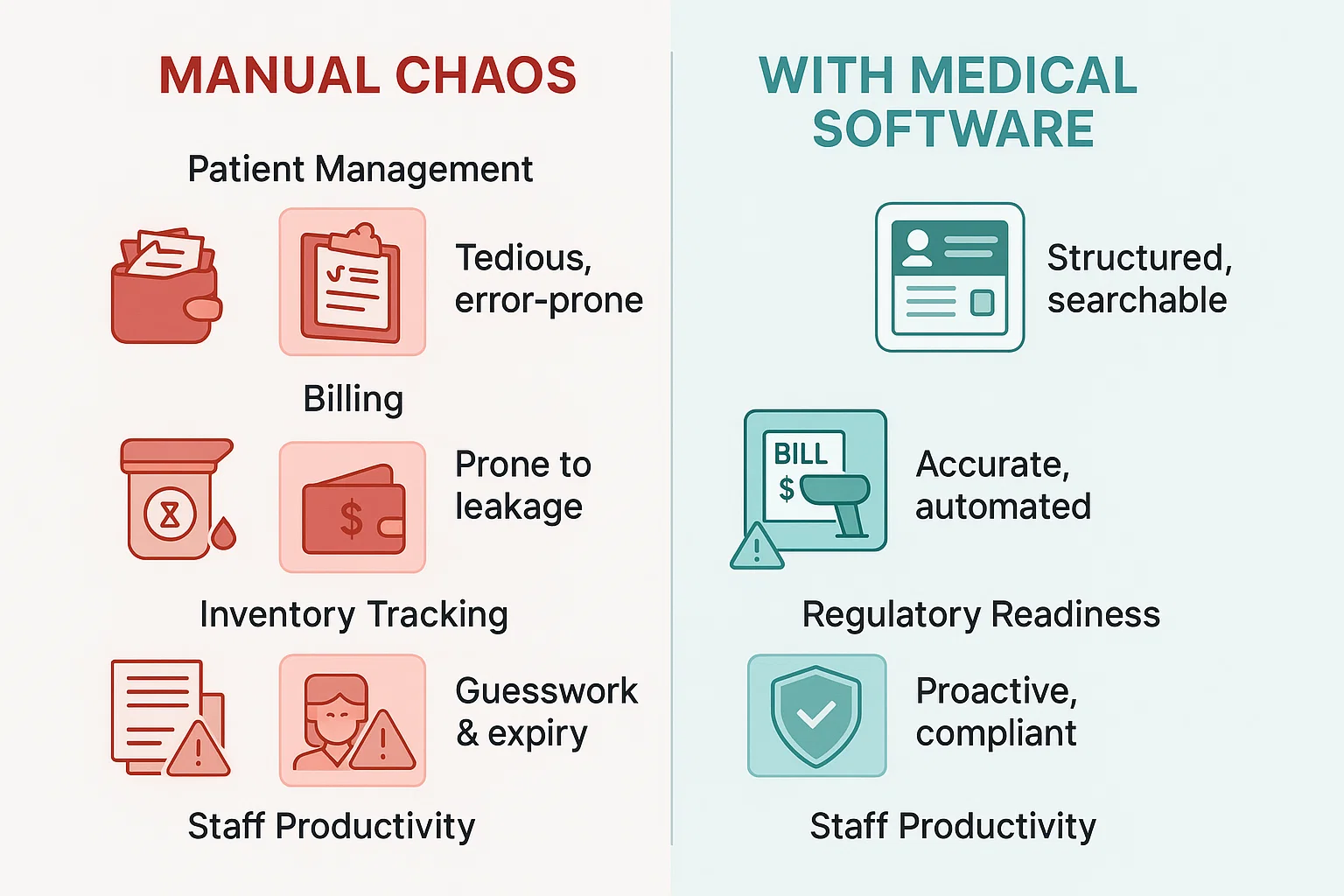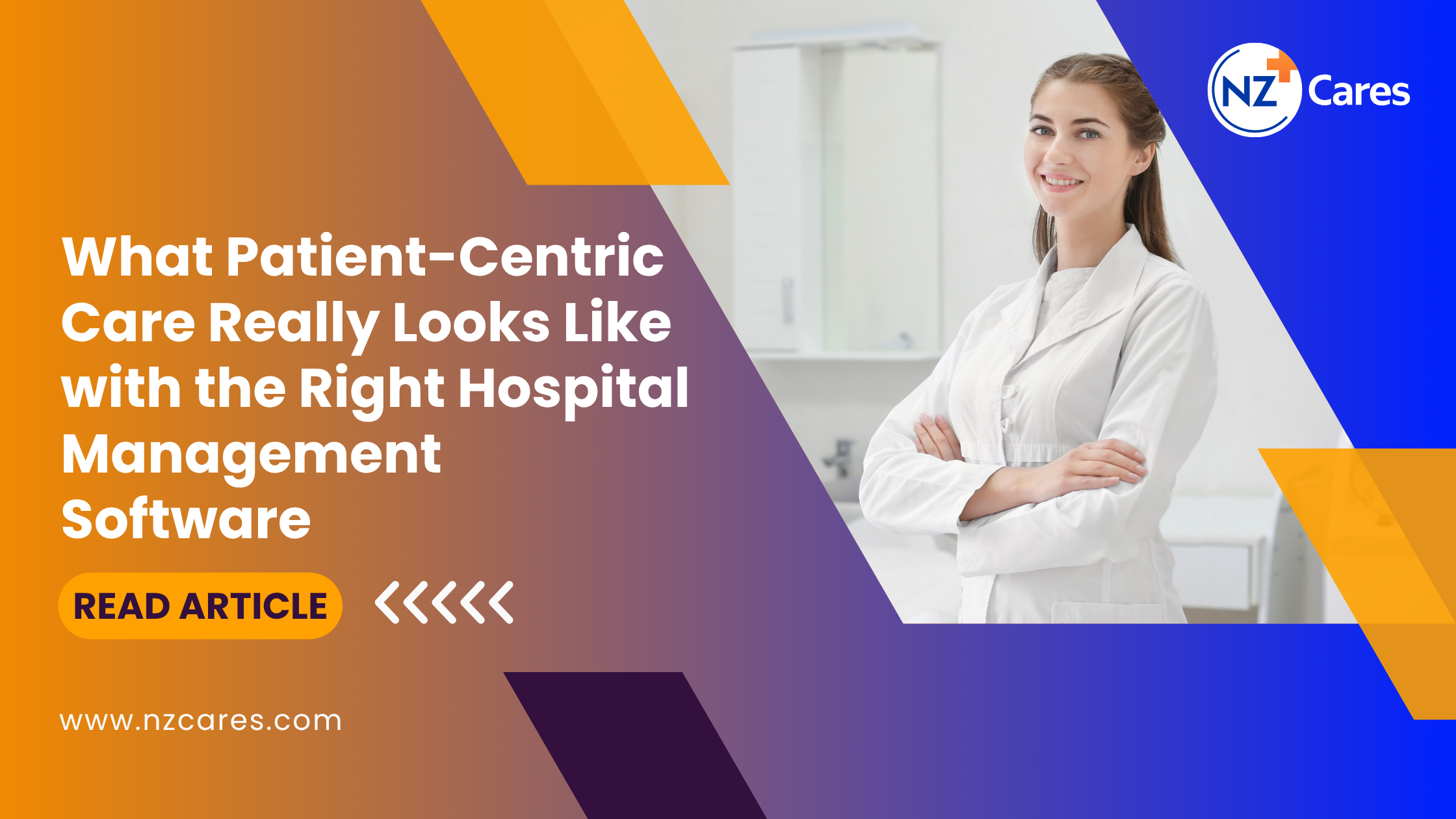Picture this: A mother calls your clinic, frantic. Her child’s lab report is missing. The receptionist flips through piles. The nurse draws blanks. Minutes pass. Confidence erodes.
This isn’t a one-off crisis—it’s a daily risk when healthcare still runs on paper and memory.
In today’s world, where everything from groceries to banking is digital, relying on handwritten records and manual scheduling isn’t just outdated—it’s dangerous. It leads to lost reports, billing errors, treatment delays, and shattered patient trust – hence the rise of digital healthcare and medical software India as well.
Smart hospital management systems like NZCares are built for this moment. From instant access to reports and automated billing to streamlined appointments and real-time updates, NZCares doesn’t just digitize healthcare—it fixes what’s broken.
Because in 2025, delivering quality care starts with smarter systems.
In this blog, we’ll unpack how modern healthcare management software designed for fertility workflows can help you simplify coordination, reduce errors, protect data, and improve patient trust without overwhelming your team.
India’s Healthcare Evolution Isn’t Waiting for Anyone
India’s healthcare system isn’t what it was five years ago. A blend of government mandates like ABDM, a booming health-tech startup culture, and a rising population of digitally aware patients has brought a seismic shift.
It’s not just about big city hospitals anymore. Even rural practitioners are exploring medical software tools that streamline patient data, reduce clerical errors, and help them stay compliant with the tightening noose of healthcare regulations.
The NASSCOM 2024 report didn’t mince words: Healthcare IT in India is on track to grow at over 20% CAGR. That includes neighborhood clinics, dental practices, fertility centers, and even wellness spas now choosing the best medical software in India.
Read More: Reimagining Primary Health Care in India: The Role of AI, Digital Innovation, and NZCares
Beyond the Buzzword: What Medical Software Really Means Today
People hear “software” and imagine a sprawling, complicated mess. But medical software today is often more intuitive than the smartphone in your pocket. Here’s what it typically includes:
EMR/EHR Systems
Electronic Medical Records (EMR) and Electronic Health Records (EHR) consolidate patient data into a structured digital format. Clinicians can access historical data, allergies, medications, lab results, radiology images, and vital signs in real-time—enabling faster, more accurate decision-making and continuity of care across departments.
Billing Modules
These modules automate the generation of invoices based on consultations, procedures, diagnostic services, and consumables. They support multi-mode payments, integrate with insurance claim systems, manage outstanding balances, and maintain detailed transaction logs to reduce errors and improve financial accountability.
Appointment Management Tools
These tools provide a centralized scheduling system for patients and providers. Real-time calendar syncing prevents overbooking, supports location-based slot availability, and allows patients to self-book or cancel appointments through web or mobile interfaces. Automated reminders help reduce no-shows and improve resource utilization.
Digital Lab Report Integration
Lab workflows are digitized—from test orders to result delivery. Reports are linked directly to patient profiles and accessible to authorized clinicians and patients. This enables faster turnaround, minimizes paper handling, and ensures secure, remote access to diagnostics.
Inventory Tracking
Inventory modules monitor medical supplies, drugs, surgical items, and consumables across departments. They track batch numbers, expiration dates, usage rates, and reorder levels. Barcode integration and alert mechanisms help prevent stockouts, pilferage, and wastage.
Teleconsultation Integration
Built-in telemedicine features enable clinicians to conduct virtual consultations with patients. These sessions are logged, with access to full patient history, digital prescriptions, and follow-up scheduling. The platform ensures compliance with regulatory frameworks for remote care delivery and patient confidentiality.
Data Security & Compliance
Modern systems are designed with multi-layered security protocols including end-to-end encryption, access control, audit trails, and secure backups. They comply with regulations such as HIPAA, GDPR, and national health data standards, ensuring both patient privacy and legal readiness.
Still Skeptical? Here’s What You’re Losing Without Medical Software
Let’s skip the theory. Here’s what’s really at stake:
Wasted Time Every Day
Manual workflows mean your staff spends hours rewriting forms, looking for files, and confirming appointments or lab requests. A digital system handles all of that in just a few clicks.
Losing Patients to More Modern Clinics
Patients today expect SMS reminders, digital prescriptions, and online access to reports. If your clinic can’t offer this, they’ll find one that does.
Avoidable Errors Keep Slipping Through
Handwritten notes, unclear prescriptions, or missed test entries can easily lead to mistakes. Software reduces these errors by automating and standardizing your workflows.
Hidden Operational Costs Add Up
You might avoid paying for software, but you’re already spending more on printing, paper, extra admin staff, and correcting mistakes. Many clinics recover their costs within months after switching to digital systems.
Compliance Isn’t Optional Anymore
Regulations like ABDM in India or HIPAA for medical tourism require proper record-keeping, data security, and audit trails. Manual systems just can’t keep up.
Breaking the Cost Myth
Many platforms are priced to suit solo clinics, with cloud-based options available for as per your budget. Larger hospitals with OPD + IPD, diagnostics, and insurance billing might spend more—but the ROI is swift and measurable.

Bonus Read: A Deep Dive into the Cost of Hospital Management Software with NZCares
India-Specific Medical Software Trends in 2025
The rise of medical software adoption in India isn’t just part of a global tech wave—it’s rooted in urgent, homegrown realities.
Doctors in India face a unique set of challenges: heavy patient loads, limited support staff, linguistic diversity, and the need to serve across both urban hospitals and rural health camps. To meet these demands, healthcare software is evolving—rapidly and in the right direction.
Here’s what’s shaping the Indian medical software landscape in 2025:
- AI Tools for Chronic Illness Detection
Predictive analytics powered by AI are now being used to flag early signs of diabetes, cardiovascular risks, kidney issues, and more—especially valuable in remote areas where early intervention can be life-saving.
- Voice-to-Text EMRs
With patient queues constantly growing, typing out records isn’t always practical. New systems offer real-time voice recognition, allowing doctors to dictate case notes in English or regional languages while staying focused on the patient.
- Regional Language Interfaces
From Marathi to Malayalam, software now includes multilingual support—not just for patient forms, but full interfaces for front desk staff, nurses, and even automated reminders. This reduces errors, builds trust, and improves accessibility for non-English-speaking users.
- Wearable Device Integration
Whether it’s tracking blood sugar for diabetic patients or heart rate anomalies in the elderly, integration with smartwatches and home-use monitors is helping clinicians make informed decisions without needing the patient to visit the clinic every time.
- Mobile-First Dashboards
Specialists and consultants, especially in Tier 2 and Tier 3 cities, often juggle multiple hospitals or clinics. Mobile-responsive dashboards ensure they can access patient records, prescriptions, and test reports on the go—without needing a desktop setup.
You may like reading: 7 Ways to Reduce Costs and Save Staff Time With AI-Powered Hospital Management Systems
One Doctor, One Software, Total Transformation
Meet Dr. Meenal, a pediatrician from Nagpur. Her clinic ran entirely on paper until 2024. She resisted the switch for years, citing complexity.
The result after adopting our medical software?
- Prescriptions and history available in 3 seconds flat
- Billing errors? Gone.
- Patient retention up 25% in six months.
Her staff? “Less exhausted, more focused,” she said.
You’re Not Behind—Yet
Here’s the hard truth: your competitors are adopting medical software in India right now. If you wait, your patients might not.
Whether you’re a cardiologist in Kolkata or a gynecologist in Coimbatore, medical software isn’t a trend. It’s a necessity.
This isn’t about becoming a tech-savvy hospital. It’s about becoming a sustainable one. Connect with NZCares team to know more and get started.
